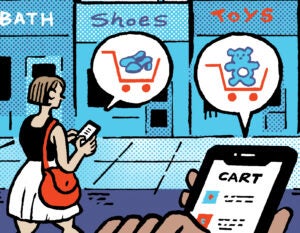 Tying mobile ad impressions to in-store visits is critical for advertisers looking to measure the value of their ads. Location analytics company Placed is approaching the challenge with a new product called Placed Attribution, that provides metrics around the number of people who saw an ad on their smartphone and then visited the advertiser’s store.
Tying mobile ad impressions to in-store visits is critical for advertisers looking to measure the value of their ads. Location analytics company Placed is approaching the challenge with a new product called Placed Attribution, that provides metrics around the number of people who saw an ad on their smartphone and then visited the advertiser’s store.
Placed Attribution gets its data from another product, Placed Insights, which consists of a panel of mobile users who install an app that collects their device’s location data. Placed then processes the raw data points to assign a place to the mobile device. The company claims to measure 100 million locations a day across more than 100,000 opted-in U.S. smartphone panelists.
“What Placed Attribution does is layer another set of data so that we can say we know panelists were exposed to an advertisement and we know they actually went into the store,” explained Placed CEO David Shim. “The conversion isn’t just some click-thru-rate…one of the nice things about having a panel that’s completely opt-in is that we see what people do in the physical world and we have a good baseline to start with.”
What the Attribution tool doesn’t do is tell advertisers if those panelists made a purchase while inside the store. While it is up to retailers to fill that gap, some industries have it easier than others, Shim added. “If you look at quick service restaurants,” he argued, “you can get a nearly 100% match between the people who walked in and those who ordered something.”
Placed is launching its Attribution tool through xAd, a mobile location-based ad platform that will incorporate Placed’s offline attribution reports into campaigns for its clients. In addition to its partnership with Placed, xAd offers its own set of location-based tools such as the ability to target mobile users through “geo-conquests.”
Aimed at consumers who visit a brand’s competitors, xAd “looks for ad requests from mobile devices and we note the lat/long data of the requestor,” explained xAd VP of marketing Monica Ho. “We’ll map those lat/longs to a specific area and see which businesses are in that area. If a client’s competitor is in the area, they can tell us that they want to serve a specific ad or store location data to people who show some kind of intent to visit their type of business.”
This approach, Ho argued, takes geo-fencing to another level by adding an extra layer of targeting so that instead of automatically serving an ad to anyone who comes within a certain range, brands can direct their ads at consumers who are searching on their phone for a certain business or have a history of visiting their competitors.
As an example, Ho pointed to Outback Steakhouse, which set up a five-mile “SmartFence” around nearby restaurants. Outback declined to comment on its use of the tool, but according to xAd, the company saw an 11% lift in conversion actions when it showed the location of its nearest restaurant to customers who crossed into the targeted area or performed a search for similar restaurants.
“This approach offers a huge potential for finding people who show intent or interest [in visiting your business],”maintained Ho, who added that xAd holds on to consumers’ mobile use data for about six months. “This extends a brand’s reach outside of their own locations and allows them to make their ads so much more relevant.”













